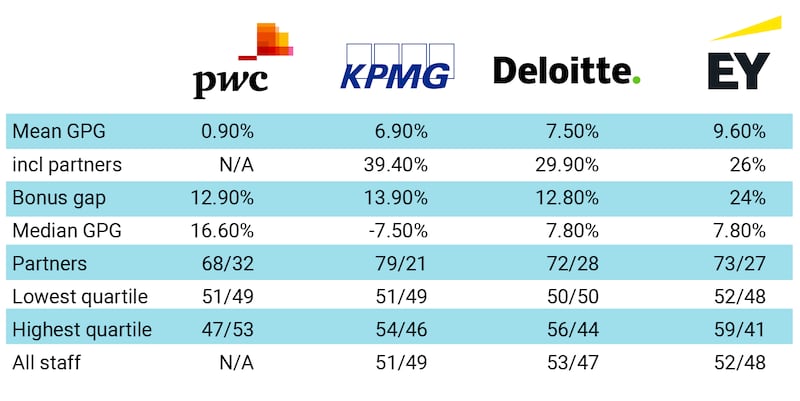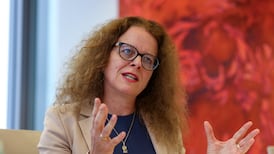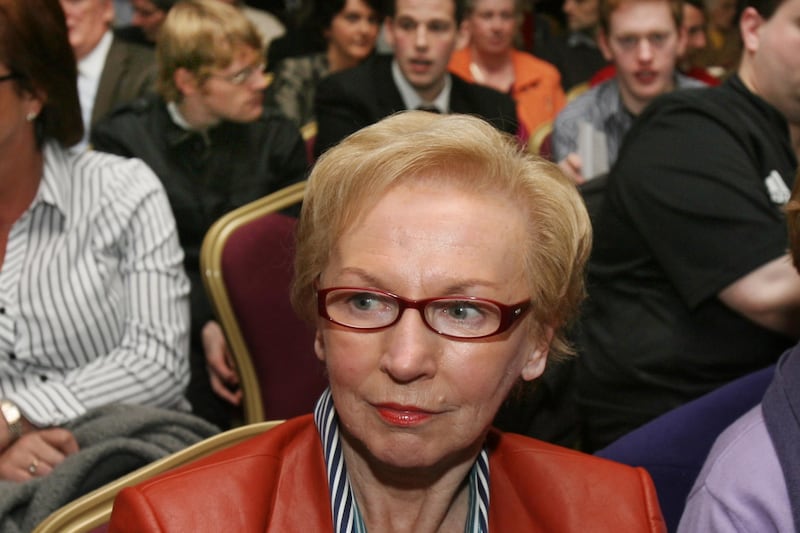Ireland’s Big Four accountancy firms are making progress towards more equal levels of woman representation in their executive ranks, according to the gender pay gap reports for the firms. But, having started from low bases, women remain substantially underrepresented among partners.
The companies – PwC, KPMG, Deloitte and EY – report mean gender pay gaps of between 0.9 per cent and 9.6 per cent in their respective reports which are based on figures compiled for the period to June of last year.
But, mirroring the State’s leading legal firms, the reported pay gaps jump very considerably when the income received by the firms’ equity partners is included – from 6.9 per cent to 39.4 per cent at KPMG, the starkest example of the three that provide both figures.

PwC, which does not provide such figures, reports the highest current proportion of woman partners at 32 per cent, with Deloitte and EY at 28 and 27 per cent respectively and KPMG at just 21 per cent.
READ MORE
Deloitte’s report gives a sense just how far the Big Four have had to come to get to this point, though, with its report revealing that just 13 per cent of its partners were women in 2012.
All of the firms provide the information required under the Gender Pay Gap Information Act 2021 in relation to salaried staff, with mean and median pay gaps, bonus gaps and gender breakdowns of the various quartiles all included in their reports. But after that, there is some divergence.
PwC, for instance, has a gender pay gap for staff of just 0.9 per cent but does not include a calculation for what the figure would be if partners were included.
In the cases of KPMG, Deloitte and EY, the numbers jump from 6.9 per cent to 39.4 per cent, 7.5 per cent to 29.9 per cent and 9.6 per cent to 26 per cent respectively, all reflecting significant gender imbalances at partner level.
[ Gender pay gap widest in finance and construction sectors, report findsOpens in new window ]
The mean pay gap is a calculation based on the average, per person, of all payments including salary, overtime and bonuses paid to men and women. It is illegal to pay staff different rates for doing the same work based on gender and the difference that emerges from the figures tends to arise due to differing levels of representation among the highest earning grades of an organisation.
In including the optional figures, which essentially treat partners – the owners of the firms – as though they were staff, the Irish firms are following the lead of their UK counterparts which caused some controversy in 2018 when they initially omitted them in an early round of that country’s mandatory gender pay gap reporting.
Rupert Soames, chief executive of outsourcing firm Serco, described the omission as “idiocy” on social media at the time and, amid other criticism, the firms then issued the figures.
Emma Codd, a managing partner at Deloitte in the UK, told the Financial Times at the time that the firm had deliberated at length over how to properly calculate the figure but had initially failed to settle on a satisfactory method.
The firms all acknowledged that the figures, when they were published, reflected the amount of work that needed to be done with regard to the promotion of woman talent to the upper echelons of their organisations. Ms Codd said that one example of the changing culture at Deloitte was that it had stopped using “very male” promotional literature, with the traditional fare having tended to include “lots of pictures of men with shot putts”.
The various companies’ literature all tends to be a model of inclusivity and the Irish firms actually tend to do better than their British counterparts when it comes to woman representation in management and other senior roles, a fact reflected in significantly lower gender pay gaps in a couple of instances.
At Deloitte, the breakdown for the upper quartile of earners in Ireland is 56/44 in favour of men. In the UK it is 65/35.
In overall terms, there are more men among the total workforces of the three Irish firms that do provide a breakdown. The differences are marginal, however. KPMG, for instance, which says its figures are based on a total of 3,805 workers, putting the split 50.7 per cent to 49.3 per cent.
[ Virgin Media Ireland reports gender pay gap of 22%Opens in new window ]
As is required, all provide a sense of the measures they are taking to promote greater equality in terms of representation, with partner level the most obvious level at which action is required.
KPMG says that “increasing the number of women partners is a firm priority. To that end, we have set an ambition to achieve 50 per cent woman partner promotions by 2025. To reach that ambition, we are focusing on retaining woman talent and supporting woman career progression through targeted supports and leadership programmes.”
Deloitte, where the mean 7.5 per cent gender pay gap is down 2.6 percentage points on 2018, points to its participation in a number of external initiatives and the promotion of some more unusual ones as having yielded some progress recently.
“We continue to see a marked increase in the number of women in senior positions; for example, on September 1st, 2022, 50 per cent of our director promotions were women. This is up from 38 per cent in 2019. In 2022, we also had the largest number of promotions ever, including 247 at management level; indicating that an even greater pipeline of future leaders, male and women, is being developed.”
The firm says that increased rates of attrition and difficulties hiring in a tight labour market were factors but suggests it is doing better when it comes to keeping woman staff. “We are encouraged that we have been able to retain a higher proportion of woman employees, with woman attrition tracking 3 per cent lower than male attrition this financial year.
“We believe this can be attributed to our investment in enhanced paid-leave policies around important life events, such as miscarriage, fostering, fertility treatment and menopause, as well as the implementation of Deloitte Works, our approach to flexible and hybrid working.”
Increased hiring overseas has also had an impact, it says, as it “has attracted more male candidates, particularly for tech roles”.
The firm puts the representation of women at director level (the highest after partner) at 44 per cent but says “that partners, as the owners of the business, is where we must see meaningful change in gender balance”.
Here, Deloitte says its target is to achieve a figure of 35 per cent woman partners by 2030, something that presumably will be aided by the fact that 80 per cent of current partners due to retire within the next 10 years are said to be men.
The firm also gives figures for the tenures, by gender, of its current partners, with women having an average of 12.6 years, men 14.2.
In its report, EY says it aims “to achieve and maintain 50:50 representation across all our ranks to partner”. By 2025, it says, the intention is “to achieve gender parity across all levels of the firm up to director level, and 35 per cent in our partnership”, before suggesting it will seek to continue to push on from there.
PwC does not provide specific targets but says that 41 per cent of new admissions to the partnership in Ireland have been women over the past three years.
The upper end of the targets for women at partner level at the UK firms tends to be 40 per cent, with KPMG for instance identifying a long-term ambition to achieve a 40:40:20 formula, the first two figures being minimum levels of representation for each gender, the third representing the balance, the composition of which may shift one way or the other over time.
[ Incomplete information in some gender pay gap reports, HR group saysOpens in new window ]
All have quite some way to go to reach those sorts of heights, however, with three of the four currently lagging their Irish counterparts. KPMG has the highest level of representation there according to the latest reports with 28 per cent, significantly above the corresponding figure in Dublin. The others are all at 25 per cent or just below.
The UK reports provide an interesting insight into how Irish reporting, still in its infancy, might develop over the coming years with the four accountancy firms there providing a considerable amount of detail on representation and pay gaps in relation to ethnicity, sexual orientation and socio-economic background as well as gender.
At Deloitte in the UK, for instance, 2.2 per cent of partners and 3.9 per cent of staff are reported to identify as lesbian, gay or bisexual while 4.5 per cent of partners and 5.1 per cent of staff have a long-term disability or health issue. Some 9 per cent of partners at the firm are from ethnic minorities, with 0.9 per cent black.



















